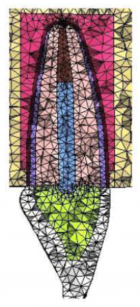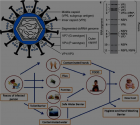Previous Issue (Volume - 8 | Issue - 1)
An Unusual Case of Hydatid Cyst Presenting as Pyopneumothorax
Published on: 5th January, 2024
A 10-year-old male child presented to the Department of Respiratory Medicine in March 2017, with complaints of dyspnea (mMRC grade 1) for last 14 months which aggravated on right lateral position, left-sided chest pain for 1 year and mild fever for 3 months. There was no hemoptysis, wheeze, and expectoration. The patient gave a past history of straw-colored pleural fluid aspiration one year ago which was diagnosed as tubercular hydropneumothorax (Figure 1) in 2016 based on pleural fluid analysis. He was given antitubercular treatment for the effusion. He took ATT for 8 months but with no improvement.
The Importance of the Concept of Acute Pneumonia for Choosing the Principles of its Treatment and Results
Published on: 30th January, 2024
Over the past many decades, scientific research and practical efforts in the field of acute nonspecific inflammation of the lung tissue have been aimed at early detection of the pathogen and its suppression.
Effect of Azithromycin on Lung Function and Pulmonary Exacerbations in Children with Post-infectious Bronchiolitis Obliterans. A Double-blind, Placebo-controlled Trial
Published on: 28th February, 2024
Introduction: Acute lower respiratory infection (ALRI) of viral etiology is a frequent consultation in pediatrics. Post-infectious bronchiolitis obliterans (PIBO) is a rare and potentially severe disorder following ALRI, characterized by partial or complete obstruction of the small airways by inflammatory tissue. There is evidence that macrolides reduce morbidity and mortality in diffuse panbronchiolitis, which may have similar inflammatory and obstructive components.We hypothesized that the effect of azithromycin (AZ) may improve lung function and reduce pulmonary exacerbations in PIBO.MethodsStudy design: A double-blind, randomized, placebo-controlled trial.Patients: We enrolled patients with PIBO followed-up at the Pulmonology department between 5 years to 18 years.Treatment regimen: The patients were randomized to receive active drug or placebo three times a week. Clinical evaluation: Clinical evaluation, pulse oximetry, lung function, and 6-min walk test were performed before and after study initiation and at 1, 3, and 6 months.CT scan and a quality of life questionnaire were performed at the beginning and the end of the Study.Results: 29 patients, 15 in G1 (10 males) and 14 in G2 (7 males) were included.There were no significant differences in FVC, FEV1, TLC, RV, or sGaw between the treatment group and controls. In addition, no significant differences were observed in exacerbations, quality of life questionnaire, or HRCT scan scores.Conclusion: No differences were observed between the groups. Further studies are necessary to allow us to find a better treatment, as azithromycin does not seem to be efficacious.
Longitudinal Risk Phenotyping in Incident Systemic Sclerosis-associated Pulmonary Arterial Hypertension (SSc-PAH): An Unsupervised Cluster Analysis of the PHAROS Registry
Published on: 15th March, 2024
Background: Systemic sclerosis-associated pulmonary arterial hypertension (SSc-PAH) is characterized by pulmonary arterial remodeling resulting in right ventricular failure and death if untreated. Despite therapeutic advances, there is survival variability within the SSc-PAH population. The aim of this study was to delineate high-risk subgroups of SSc-PAH using readily available clinical parameters.Methods: We analyzed data from the PHAROS database, a prospective observational registry of incident SSc-PAH patients. Latent class modeling was performed based on trends in 6MWD over time. We compared survival between the clusters regarding baseline clinical parameters and changes in these parameters over time.Results: We identified four unique groups within 103 patients meeting our inclusion criteria, based on trajectories of 6MWD. Patients in Cluster 4 exhibited a decline in 6MWD over time and had the worst prognosis with a median survival of 3 years. Patients in Cluster 3, with the lowest baseline 6MWD, were associated with lower median survival (5 years) when compared to Clusters 1 and 2 (> 9 and 7 years, respectively), despite an improvement in 6MWD over time. There were no meaningful changes in SF-36 and WHO functional class between the clusters, but BNP trended higher over time in the higher-risk clusters. Conclusion: We identified high-risk subsets of SSc-PAH characterized by significantly worse survival. Incident SSc-PAH patients with a decline in 6MWD over time or low baseline 6MWD had worse survival when compared to SSc-PAH patients who demonstrated relatively stable or mild reduction in 6MWD over time.
Intradermal and Subcutaneous Lignocaine for Arterial Blood Gas Sampling: A Randomized Controlled Trial
Published on: 19th March, 2024
Introduction: The use of local anesthesia (LA) prior to arterial blood gas sampling is recommended but is not widely used. We tested the hypothesis that intradermal administration of local anesthesia would be as effective as subcutaneous administration in reducing pain from arterial blood gas sampling.Aims: The primary aim of this study was to evaluate the effect of intradermal and subcutaneous lignocaine on patient-perceived pain during arterial blood gas sampling. The secondary aims were to evaluate if different routes of LA administration had an impact on the difficulty and complications of ABG sampling.Methods: We undertook a randomized, single-blind, placebo-controlled trial in New Zealand. We enrolled patients attending a nurse-led outpatient oxygen clinic who were 18 to 90 years of age and who had an oxygen saturation of 93% or less at rest. Patients were randomly assigned to receive intradermal 1% lignocaine, subcutaneous 1% lignocaine, or subcutaneous normal saline. Patients and nurse assessors were blinded to the treatment allocation. The primary endpoint was a patient-assessed pain score using a graphic rating scale (0-10).Results: 135 patients were randomized (54 patients in the intradermal lignocaine group, 54 patients in the subcutaneous lignocaine group, and 27 in the subcutaneous saline group). The mean patient-assessed pain score for the intradermal lignocaine group was 1.8 (+/- 1.1), which was a relative reduction of 47% (95% C.I. 31%-59%, p < 0.0001) from the mean patient-assessed pain score of 3.4 (+/- 1.1) for the subcutaneous saline group. The mean patient-assessed pain score for the subcutaneous lignocaine group was 2.1 (+/- 1.1), which was also a significant relative reduction of 36% (95% C.I. 17%-51%, p = 0.0001) compared to the subcutaneous saline group. Intradermal lignocaine reduced pain more than subcutaneous lignocaine, with a relative pain reduction difference of 20% (95% CI -4%-49%, p = 0.05). Bruising was more frequent in the subcutaneous lignocaine group (9.3%) than in the intradermal (0%) and saline groups (0%). Conclusion: Intradermal lignocaine is at least as effective as subcutaneous lignocaine for reducing patient-perceived pain from arterial blood gas sampling and results in less bruising.
Macitentan in Adults with Sickle Cell Disease and Pulmonary Hypertension: A Proof-of-Concept Study
Published on: 22nd April, 2024
Pulmonary hypertension (PH) in sickle cell disease (SCD) is associated with a mortality rate of 37%. There is an upregulation of adhesion molecules which leads to the expression of endothelin-1, a potent vasoconstrictor. A prospective, descriptive study was done to determine the safety and efficacy of macitentan in patients with SCD and PH. Continuous variables were reported as mean ± SEM or percentage where appropriate. We screened 13 patients and recruited five. All five patients were adults. Data were analyzed as appropriate by student t - test. Statistical significance was assumed at p < 0.05. Baseline pulmonary hemodynamics obtained by right heart catheterization and systemic hemodynamics were (± SEM): mean pulmonary artery pressure (MPAP) 32 ± 8 mmHg, right atrial pressure (RAP) 9 ± 4 mmHg, pulmonary vascular resistance (PVR) 257 dynes-sec/cm5 and CI 3·7 ± 0.39 l/m2. Of all parameters, only PVR and 6-min walk distance changed significantly. For the group, MPAP decreased by 15.6%, PVR by 22.5% and RAP by 25.5%. The 6-minute walk distance increased over sixteen weeks except in Patient 4 who had a 3% decrease. The mean walk distance increased in the total distance, from 464 ± 158 meters to 477 ± 190 meters (p .123). In four patients, the adverse events were mild to moderate and did not lead to study drug discontinuation. Significant improvement in pulmonary hemodynamics and exercise capacity in patients with SCD-related pulmonary arterial hypertension. We found that macitentan was safe and well tolerated.

HSPI: We're glad you're here. Please click "create a new Query" if you are a new visitor to our website and need further information from us.
If you are already a member of our network and need to keep track of any developments regarding a question you have already submitted, click "take me to my Query."


















































































































































